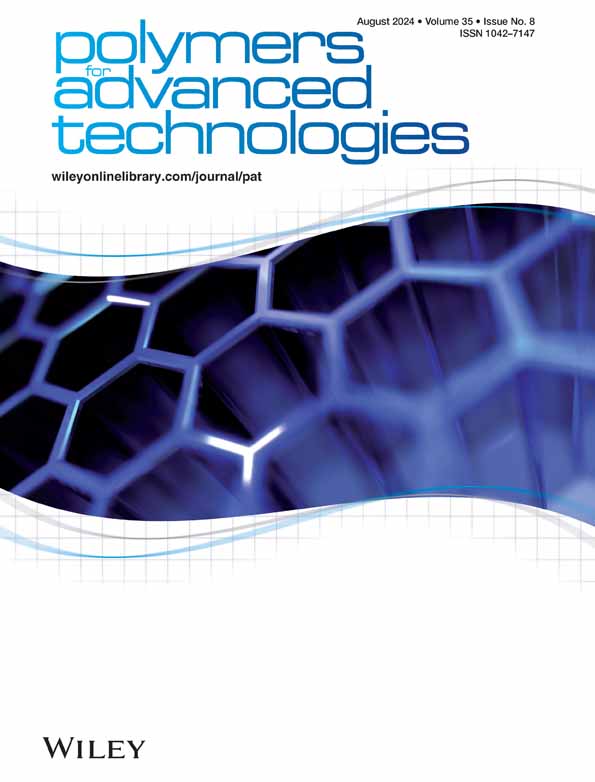Advancement of constant and progressive load multi‐cycle indentation method on surface properties characterization of polymers
IF 3.4
4区 工程技术
Q2 POLYMER SCIENCE
引用次数: 0
Abstract
In recent years, polymers have been popular in industrial applications due to their lightweight, corrosion‐resistant, improved surface polish, ease of manufacturing, cost‐effectiveness, and so forth. Similarly, micro/nano‐indentation has gained popularity as a technique for assessing the surface mechanical characteristics of polymers. The present study conducted comprehensive experiments using cyclic micro‐indentation on engineering polymers, specifically poly‐ether‐ether‐ketone (PEEK), poly(methyl methacrylate) (PMMA), and poly(tetra‐fluoroethylene) (PTFE). An appropriate and optimal indentation method has been proposed after analyzing the behavior and significance of all the input parameters in evaluating the properties. Both constant load multi‐cycle (CLMC) and progressive load multi‐cycle (PLMC) were considered for this investigation. A comparative evaluation has been conducted to assess two multi‐cycle tests on these materials. From the analysis of the input parameters, including maximum loads, loading and unloading rates, and the number of cycles, the unloading rate and indentation cycle are crucial factors in determining hardness (恒定和渐进加载多循环压痕法在聚合物表面特性表征中的应用进展
近年来,聚合物因其重量轻、耐腐蚀、表面光洁度高、易于制造、成本效益高等优点而在工业应用中大受欢迎。同样,微/纳米压痕技术作为一种评估聚合物表面机械特性的技术也越来越受欢迎。本研究对工程聚合物,特别是聚醚醚酮(PEEK)、聚甲基丙烯酸甲酯(PMMA)和聚四氟乙烯(PTFE)进行了循环微压痕综合实验。在分析了所有输入参数在性能评估中的行为和意义后,提出了一种适当的最佳压痕方法。本次研究同时考虑了恒定载荷多循环(CLMC)和渐进载荷多循环(PLMC)两种方法。对这些材料的两种多循环测试进行了比较评估。从对输入参数(包括最大载荷、加载和卸载速率以及循环次数)的分析来看,卸载速率和压痕循环是决定硬度(H)和弹性模量(E)的关键因素。对于所有三种材料来说,加载速率的增加都会导致 H 的增加和 E 的减少。这种效应源于热效应,其特点是蠕变模量和闭合滞后环。在恒定载荷多循环中使用保持时间和多循环数据可以显著影响蠕变行为和疲劳行为滞后环的使用。同样,力大于 0.5 N 且至少循环五次的渐进加载多循环压痕是评估表面机械参数的最准确方法。
本文章由计算机程序翻译,如有差异,请以英文原文为准。
求助全文
约1分钟内获得全文
求助全文
来源期刊

Polymers for Advanced Technologies
工程技术-高分子科学
CiteScore
6.20
自引率
5.90%
发文量
337
审稿时长
2.1 months
期刊介绍:
Polymers for Advanced Technologies is published in response to recent significant changes in the patterns of materials research and development. Worldwide attention has been focused on the critical importance of materials in the creation of new devices and systems. It is now recognized that materials are often the limiting factor in bringing a new technical concept to fruition and that polymers are often the materials of choice in these demanding applications. A significant portion of the polymer research ongoing in the world is directly or indirectly related to the solution of complex, interdisciplinary problems whose successful resolution is necessary for achievement of broad system objectives.
Polymers for Advanced Technologies is focused to the interest of scientists and engineers from academia and industry who are participating in these new areas of polymer research and development. It is the intent of this journal to impact the polymer related advanced technologies to meet the challenge of the twenty-first century.
Polymers for Advanced Technologies aims at encouraging innovation, invention, imagination and creativity by providing a broad interdisciplinary platform for the presentation of new research and development concepts, theories and results which reflect the changing image and pace of modern polymer science and technology.
Polymers for Advanced Technologies aims at becoming the central organ of the new multi-disciplinary polymer oriented materials science of the highest scientific standards. It will publish original research papers on finished studies; communications limited to five typewritten pages plus three illustrations, containing experimental details; review articles of up to 40 pages; letters to the editor and book reviews. Review articles will normally be published by invitation. The Editor-in-Chief welcomes suggestions for reviews.
 求助内容:
求助内容: 应助结果提醒方式:
应助结果提醒方式:


